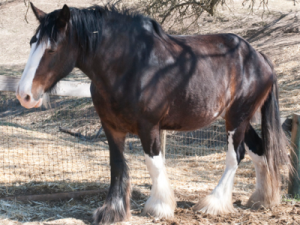 Guidelines for vaccination of horses include both core vaccines required for all horses, regardless of risk and non-core vaccines required only for specific horses based on risk analysis of their environment and exposure to disease. Remember that vaccination is only one element of an overall infectious disease control program. The other important factors are reduction of exposure to infectious agents in the environment and minimizing factors that decrease resistance or increase susceptibility to disease including stress, over-crowding, parasitism, poor nutrition, or contaminated water supply.
Guidelines for vaccination of horses include both core vaccines required for all horses, regardless of risk and non-core vaccines required only for specific horses based on risk analysis of their environment and exposure to disease. Remember that vaccination is only one element of an overall infectious disease control program. The other important factors are reduction of exposure to infectious agents in the environment and minimizing factors that decrease resistance or increase susceptibility to disease including stress, over-crowding, parasitism, poor nutrition, or contaminated water supply.
When considering vaccination for your horses, it is important to consider several factors: the risk of disease for your horse (his exposure, environment, breed, use and sex), the consequences of that disease (morbidity, mortality, loss of competition, zoonotic potential), effectiveness of the vaccine, potential for adverse events, and the cost of immunization. Remember that vaccines used in the face of poor management will be less effective. Vaccines are used to minimize the risk of infection but do not always prevent disease. Vaccines are not immediately protective, they usually require a priming series of multiple vaccines before active immunity is developed.
Core vaccines are defined as those that protect from endemic diseases, with potential public health significance (zoonotic), are required by law, are virulent or highly infectious, and pose a risk of severe disease. These vaccines are extremely effective (high patient benefit) and have a low level of risk for adverse events thus should be used in most patients. The core vaccine for US horses are tetanus, EEE/WEE, West Nile Virus and Rabies. All of these vaccines require annual revaccination. Since EEE/WEE and WNV diseases are passed by mosquitoes, vaccination for those diseases should be done in the spring and should also include mosquito control at any standing water and the use of insect repellent for your horses.
Risk-based vaccines (non-core) should only be used when indicated by the exposure and environment for specific horses. Horses, especially horses less than 5 years of age, exposed to ‘transient populations’ (show, race or other competitive horses and horses going to/from breeding farms) should be vaccinated for equine herpesvirus (rhinopneumonitis) and equine influenza. These vaccines should be administered every 6 months. Breeding farms should consider their risk for strangles, rotavirus diarrhea and equine viral arteritis. All of these vaccines have very specific recommendations and should be reviewed carefully with your veterinarian prior to consideration for inclusion in your vaccine protocol.
There are also a number of ‘regional’ diseases that affect horses and should be considered based on where you live. Potomac Horse Fever affects horses in the Eastern United States, and now some other specific areas. This vaccine is not labeled to prevent abortion. Due to the relatively low efficacy of the vaccine, revaccination every 3 – 4 months is recommended in endemic areas. Other regional diseases that require vaccination in specific locales are anthrax and botulism. Although Lyme Disease has regional distribution, there is no vaccine licensed (or with research data of effectiveness) for horses. Tick control seems to be the best method of preventing Lyme Disease. None of these disease agents have high incidence in Southern Oregon.
One last available vaccine for consideration is the Crotalus atrox toxoid vaccine for pre-exposure vaccination protection from rattlesnake bites. This vaccine is developed from the Western Diamondback toxin but has a label claim to provide protection from Prairie, Great Basin, Northern and Southern Pacific Rattlesnakes, Sidewinders, Timber Rattlesnake, Massasauga and Copperheads, and partial protection from the Eastern Diamondback Rattlesnake. There is no protection from Water Moccasin/Cottonmouth, Mojave Rattlesnake or Coral Snake. This vaccine requires a primary series of 3 doses, one month apart (after 6 months of age), followed by booster doses every 6 months.
As you can see, there are a lot of equine vaccines. All horses should receive annual boosters for tetanus, EEE/WEE, WNV and Rabies. Other vaccines should only be added when there is significant risk for disease. Your veterinarian should be consulted in the selection of non-core vaccines.
-based on 2012 AAEP Vaccination Guidelines

